Change Management Report: Implementing New Technology in a Restaurant
VerifiedAdded on 2021/05/31
|7
|1930
|61
Report
AI Summary
This report examines change management strategies for a restaurant aiming to implement new table-top technology. It analyzes the impact on staff, including waiting and kitchen staff, and the overall business operations. The report highlights the reasons for adopting the new technology, such as increased efficiency and customer satisfaction, while also addressing potential resistance to change from employees concerned about job security and the integration of new systems. The report then applies Kotter's 8-step change model, detailing each step from creating a sense of urgency to anchoring the change within the organization's culture. The report concludes by emphasizing the importance of a well-defined change management strategy for successful technology integration, providing a comprehensive overview of the challenges and solutions involved in organizational transformation.

[Type the document title]
[Type the document subtitle]
[Pick the date]
System04002
qwertyuiopasdfghjklzxcvbnmq
ertyuiopasdfghjklzxcvbnmqwe
yuiopasdfghjklzxcvbnmqwerty
opasdfghjklzxcvbnmqwertyuio
sdfghjklzxcvbnmqwertyuiopas
ghjklzxcvbnmqwertyuiopasdfg
klzxcvbnmqwertyuiopasdfghjk
xcvbnmqwertyuiopasdfghjklzx
bnmqwertyuiopasdfghjklzxcvb
mqwertyuiopasdfghjklzxcvbnm
wertyuiopasdfghjklzxcvbnmqw
rtyuiopasdfghjklzxcvbnmqwer
uiopasdfghjklzxcvbnmqwertyu
pasdfghjklzxcvbnmqwertyuiop
[Type the document subtitle]
[Pick the date]
System04002
qwertyuiopasdfghjklzxcvbnmq
ertyuiopasdfghjklzxcvbnmqwe
yuiopasdfghjklzxcvbnmqwerty
opasdfghjklzxcvbnmqwertyuio
sdfghjklzxcvbnmqwertyuiopas
ghjklzxcvbnmqwertyuiopasdfg
klzxcvbnmqwertyuiopasdfghjk
xcvbnmqwertyuiopasdfghjklzx
bnmqwertyuiopasdfghjklzxcvb
mqwertyuiopasdfghjklzxcvbnm
wertyuiopasdfghjklzxcvbnmqw
rtyuiopasdfghjklzxcvbnmqwer
uiopasdfghjklzxcvbnmqwertyu
pasdfghjklzxcvbnmqwertyuiop
Paraphrase This Document
Need a fresh take? Get an instant paraphrase of this document with our AI Paraphraser
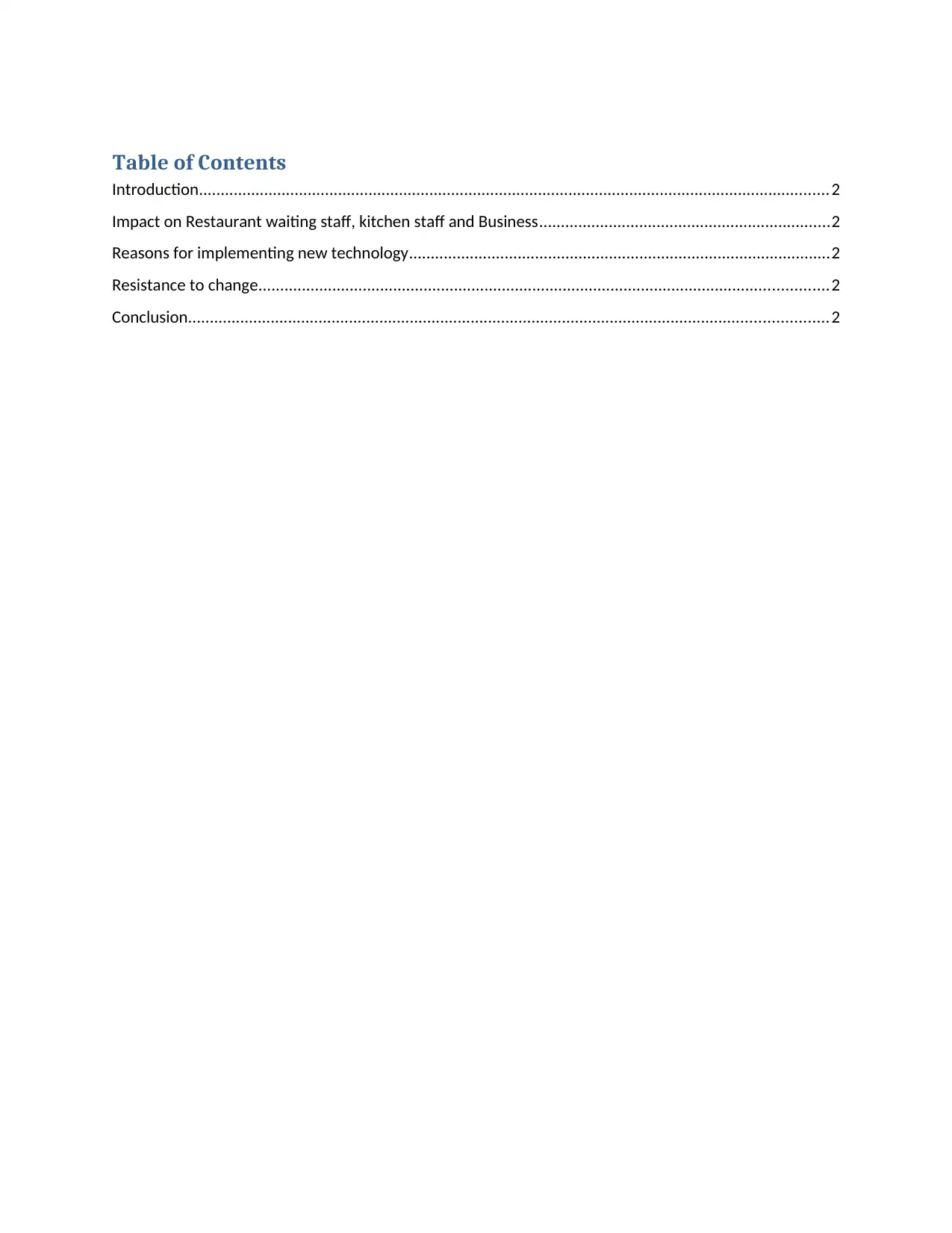
Change management 1
Table of Contents
Introduction.................................................................................................................................................2
Impact on Restaurant waiting staff, kitchen staff and Business...................................................................2
Reasons for implementing new technology.................................................................................................2
Resistance to change...................................................................................................................................2
Conclusion...................................................................................................................................................2
dfghjklzxcvbnmqwertyuiopasd
Table of Contents
Introduction.................................................................................................................................................2
Impact on Restaurant waiting staff, kitchen staff and Business...................................................................2
Reasons for implementing new technology.................................................................................................2
Resistance to change...................................................................................................................................2
Conclusion...................................................................................................................................................2
dfghjklzxcvbnmqwertyuiopasd
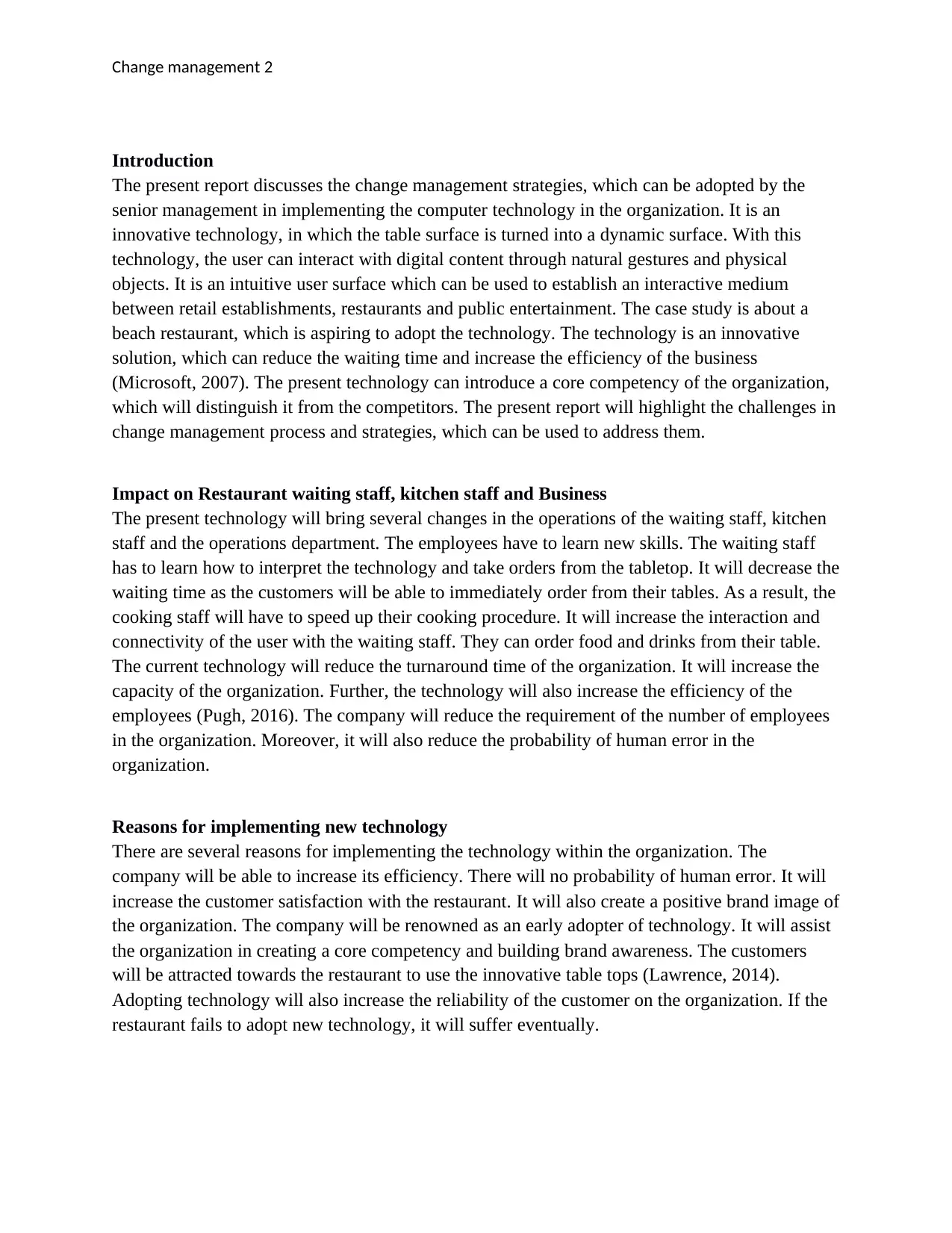
Change management 2
Introduction
The present report discusses the change management strategies, which can be adopted by the
senior management in implementing the computer technology in the organization. It is an
innovative technology, in which the table surface is turned into a dynamic surface. With this
technology, the user can interact with digital content through natural gestures and physical
objects. It is an intuitive user surface which can be used to establish an interactive medium
between retail establishments, restaurants and public entertainment. The case study is about a
beach restaurant, which is aspiring to adopt the technology. The technology is an innovative
solution, which can reduce the waiting time and increase the efficiency of the business
(Microsoft, 2007). The present technology can introduce a core competency of the organization,
which will distinguish it from the competitors. The present report will highlight the challenges in
change management process and strategies, which can be used to address them.
Impact on Restaurant waiting staff, kitchen staff and Business
The present technology will bring several changes in the operations of the waiting staff, kitchen
staff and the operations department. The employees have to learn new skills. The waiting staff
has to learn how to interpret the technology and take orders from the tabletop. It will decrease the
waiting time as the customers will be able to immediately order from their tables. As a result, the
cooking staff will have to speed up their cooking procedure. It will increase the interaction and
connectivity of the user with the waiting staff. They can order food and drinks from their table.
The current technology will reduce the turnaround time of the organization. It will increase the
capacity of the organization. Further, the technology will also increase the efficiency of the
employees (Pugh, 2016). The company will reduce the requirement of the number of employees
in the organization. Moreover, it will also reduce the probability of human error in the
organization.
Reasons for implementing new technology
There are several reasons for implementing the technology within the organization. The
company will be able to increase its efficiency. There will no probability of human error. It will
increase the customer satisfaction with the restaurant. It will also create a positive brand image of
the organization. The company will be renowned as an early adopter of technology. It will assist
the organization in creating a core competency and building brand awareness. The customers
will be attracted towards the restaurant to use the innovative table tops (Lawrence, 2014).
Adopting technology will also increase the reliability of the customer on the organization. If the
restaurant fails to adopt new technology, it will suffer eventually.
Introduction
The present report discusses the change management strategies, which can be adopted by the
senior management in implementing the computer technology in the organization. It is an
innovative technology, in which the table surface is turned into a dynamic surface. With this
technology, the user can interact with digital content through natural gestures and physical
objects. It is an intuitive user surface which can be used to establish an interactive medium
between retail establishments, restaurants and public entertainment. The case study is about a
beach restaurant, which is aspiring to adopt the technology. The technology is an innovative
solution, which can reduce the waiting time and increase the efficiency of the business
(Microsoft, 2007). The present technology can introduce a core competency of the organization,
which will distinguish it from the competitors. The present report will highlight the challenges in
change management process and strategies, which can be used to address them.
Impact on Restaurant waiting staff, kitchen staff and Business
The present technology will bring several changes in the operations of the waiting staff, kitchen
staff and the operations department. The employees have to learn new skills. The waiting staff
has to learn how to interpret the technology and take orders from the tabletop. It will decrease the
waiting time as the customers will be able to immediately order from their tables. As a result, the
cooking staff will have to speed up their cooking procedure. It will increase the interaction and
connectivity of the user with the waiting staff. They can order food and drinks from their table.
The current technology will reduce the turnaround time of the organization. It will increase the
capacity of the organization. Further, the technology will also increase the efficiency of the
employees (Pugh, 2016). The company will reduce the requirement of the number of employees
in the organization. Moreover, it will also reduce the probability of human error in the
organization.
Reasons for implementing new technology
There are several reasons for implementing the technology within the organization. The
company will be able to increase its efficiency. There will no probability of human error. It will
increase the customer satisfaction with the restaurant. It will also create a positive brand image of
the organization. The company will be renowned as an early adopter of technology. It will assist
the organization in creating a core competency and building brand awareness. The customers
will be attracted towards the restaurant to use the innovative table tops (Lawrence, 2014).
Adopting technology will also increase the reliability of the customer on the organization. If the
restaurant fails to adopt new technology, it will suffer eventually.
⊘ This is a preview!⊘
Do you want full access?
Subscribe today to unlock all pages.

Trusted by 1+ million students worldwide
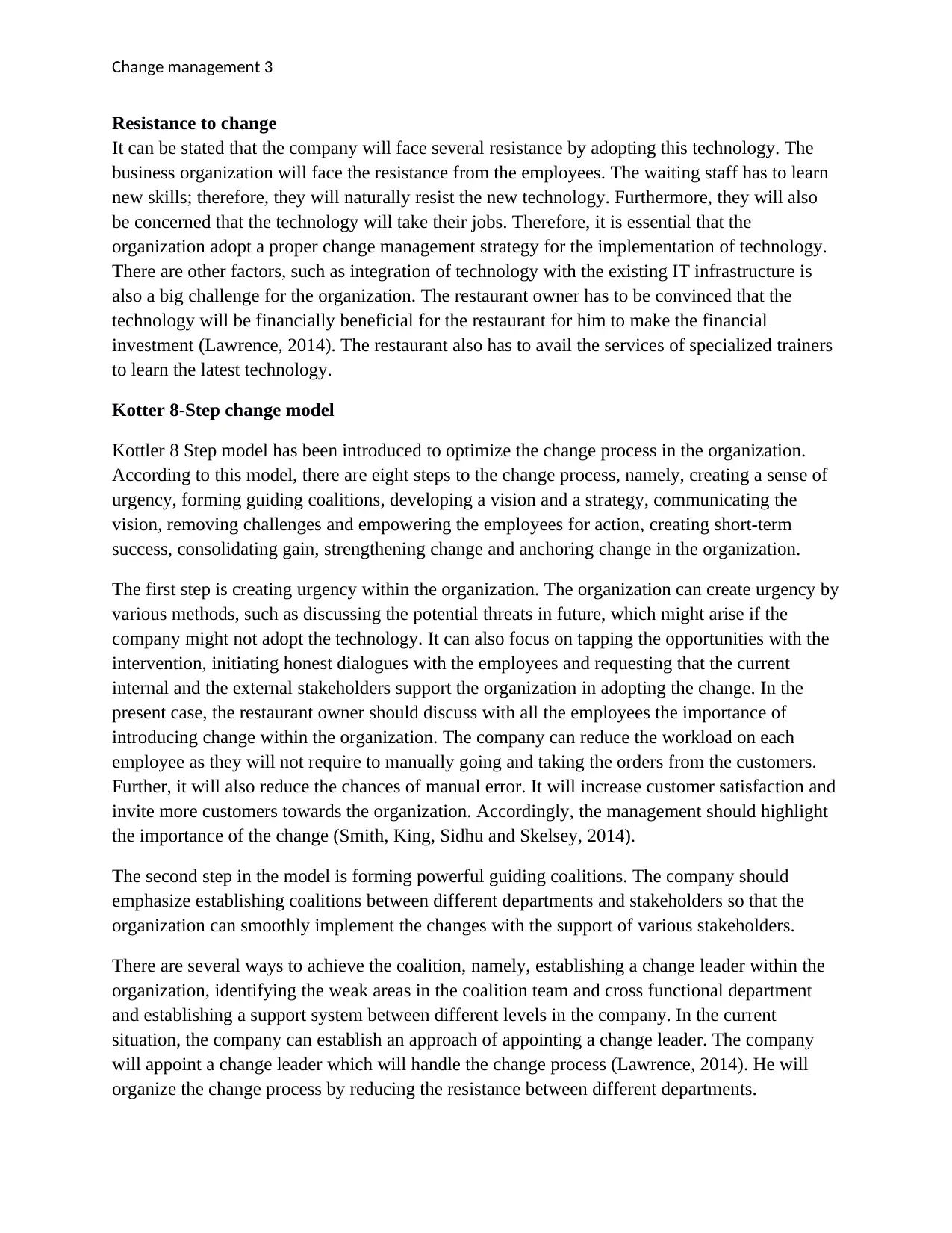
Change management 3
Resistance to change
It can be stated that the company will face several resistance by adopting this technology. The
business organization will face the resistance from the employees. The waiting staff has to learn
new skills; therefore, they will naturally resist the new technology. Furthermore, they will also
be concerned that the technology will take their jobs. Therefore, it is essential that the
organization adopt a proper change management strategy for the implementation of technology.
There are other factors, such as integration of technology with the existing IT infrastructure is
also a big challenge for the organization. The restaurant owner has to be convinced that the
technology will be financially beneficial for the restaurant for him to make the financial
investment (Lawrence, 2014). The restaurant also has to avail the services of specialized trainers
to learn the latest technology.
Kotter 8-Step change model
Kottler 8 Step model has been introduced to optimize the change process in the organization.
According to this model, there are eight steps to the change process, namely, creating a sense of
urgency, forming guiding coalitions, developing a vision and a strategy, communicating the
vision, removing challenges and empowering the employees for action, creating short-term
success, consolidating gain, strengthening change and anchoring change in the organization.
The first step is creating urgency within the organization. The organization can create urgency by
various methods, such as discussing the potential threats in future, which might arise if the
company might not adopt the technology. It can also focus on tapping the opportunities with the
intervention, initiating honest dialogues with the employees and requesting that the current
internal and the external stakeholders support the organization in adopting the change. In the
present case, the restaurant owner should discuss with all the employees the importance of
introducing change within the organization. The company can reduce the workload on each
employee as they will not require to manually going and taking the orders from the customers.
Further, it will also reduce the chances of manual error. It will increase customer satisfaction and
invite more customers towards the organization. Accordingly, the management should highlight
the importance of the change (Smith, King, Sidhu and Skelsey, 2014).
The second step in the model is forming powerful guiding coalitions. The company should
emphasize establishing coalitions between different departments and stakeholders so that the
organization can smoothly implement the changes with the support of various stakeholders.
There are several ways to achieve the coalition, namely, establishing a change leader within the
organization, identifying the weak areas in the coalition team and cross functional department
and establishing a support system between different levels in the company. In the current
situation, the company can establish an approach of appointing a change leader. The company
will appoint a change leader which will handle the change process (Lawrence, 2014). He will
organize the change process by reducing the resistance between different departments.
Resistance to change
It can be stated that the company will face several resistance by adopting this technology. The
business organization will face the resistance from the employees. The waiting staff has to learn
new skills; therefore, they will naturally resist the new technology. Furthermore, they will also
be concerned that the technology will take their jobs. Therefore, it is essential that the
organization adopt a proper change management strategy for the implementation of technology.
There are other factors, such as integration of technology with the existing IT infrastructure is
also a big challenge for the organization. The restaurant owner has to be convinced that the
technology will be financially beneficial for the restaurant for him to make the financial
investment (Lawrence, 2014). The restaurant also has to avail the services of specialized trainers
to learn the latest technology.
Kotter 8-Step change model
Kottler 8 Step model has been introduced to optimize the change process in the organization.
According to this model, there are eight steps to the change process, namely, creating a sense of
urgency, forming guiding coalitions, developing a vision and a strategy, communicating the
vision, removing challenges and empowering the employees for action, creating short-term
success, consolidating gain, strengthening change and anchoring change in the organization.
The first step is creating urgency within the organization. The organization can create urgency by
various methods, such as discussing the potential threats in future, which might arise if the
company might not adopt the technology. It can also focus on tapping the opportunities with the
intervention, initiating honest dialogues with the employees and requesting that the current
internal and the external stakeholders support the organization in adopting the change. In the
present case, the restaurant owner should discuss with all the employees the importance of
introducing change within the organization. The company can reduce the workload on each
employee as they will not require to manually going and taking the orders from the customers.
Further, it will also reduce the chances of manual error. It will increase customer satisfaction and
invite more customers towards the organization. Accordingly, the management should highlight
the importance of the change (Smith, King, Sidhu and Skelsey, 2014).
The second step in the model is forming powerful guiding coalitions. The company should
emphasize establishing coalitions between different departments and stakeholders so that the
organization can smoothly implement the changes with the support of various stakeholders.
There are several ways to achieve the coalition, namely, establishing a change leader within the
organization, identifying the weak areas in the coalition team and cross functional department
and establishing a support system between different levels in the company. In the current
situation, the company can establish an approach of appointing a change leader. The company
will appoint a change leader which will handle the change process (Lawrence, 2014). He will
organize the change process by reducing the resistance between different departments.
Paraphrase This Document
Need a fresh take? Get an instant paraphrase of this document with our AI Paraphraser
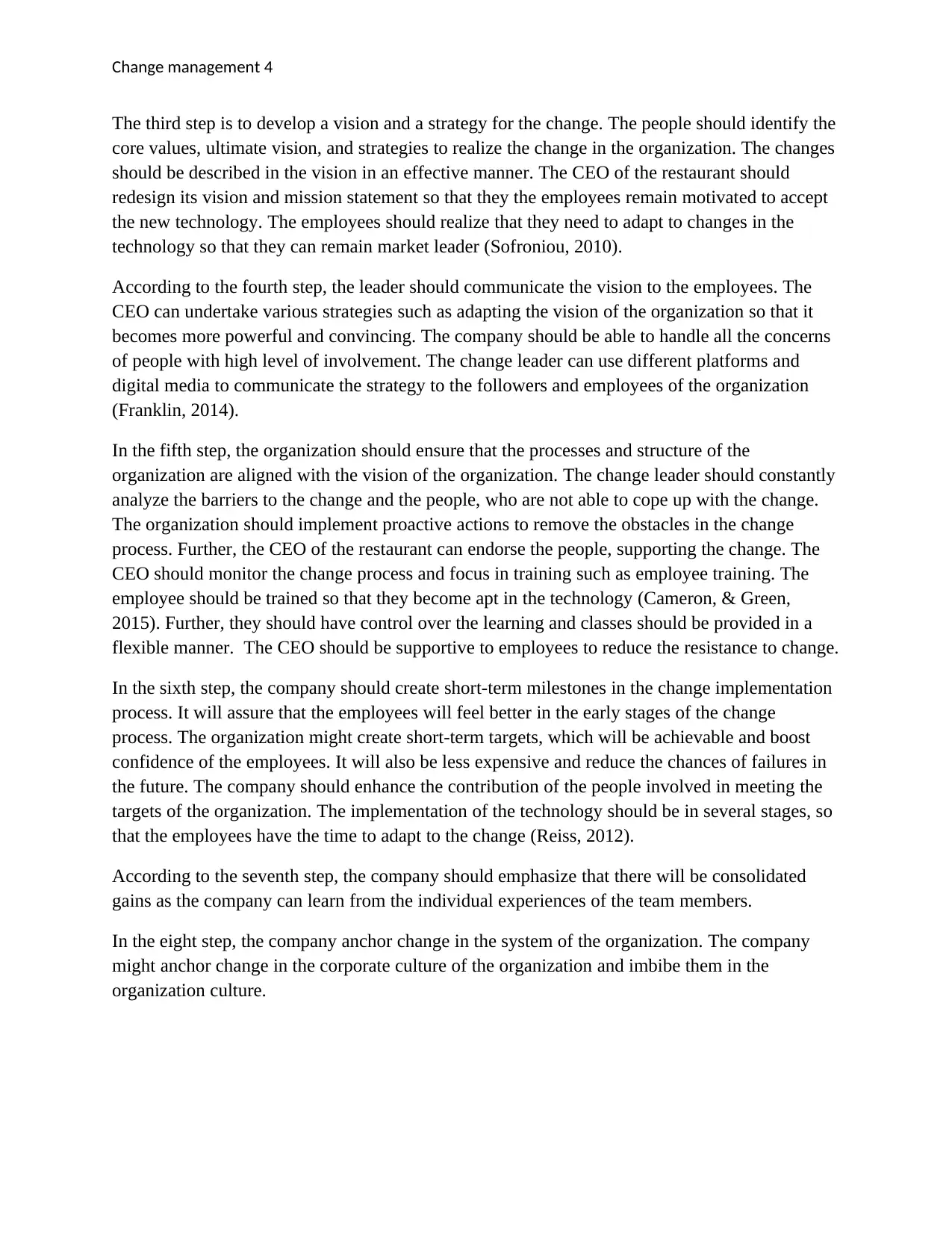
Change management 4
The third step is to develop a vision and a strategy for the change. The people should identify the
core values, ultimate vision, and strategies to realize the change in the organization. The changes
should be described in the vision in an effective manner. The CEO of the restaurant should
redesign its vision and mission statement so that they the employees remain motivated to accept
the new technology. The employees should realize that they need to adapt to changes in the
technology so that they can remain market leader (Sofroniou, 2010).
According to the fourth step, the leader should communicate the vision to the employees. The
CEO can undertake various strategies such as adapting the vision of the organization so that it
becomes more powerful and convincing. The company should be able to handle all the concerns
of people with high level of involvement. The change leader can use different platforms and
digital media to communicate the strategy to the followers and employees of the organization
(Franklin, 2014).
In the fifth step, the organization should ensure that the processes and structure of the
organization are aligned with the vision of the organization. The change leader should constantly
analyze the barriers to the change and the people, who are not able to cope up with the change.
The organization should implement proactive actions to remove the obstacles in the change
process. Further, the CEO of the restaurant can endorse the people, supporting the change. The
CEO should monitor the change process and focus in training such as employee training. The
employee should be trained so that they become apt in the technology (Cameron, & Green,
2015). Further, they should have control over the learning and classes should be provided in a
flexible manner. The CEO should be supportive to employees to reduce the resistance to change.
In the sixth step, the company should create short-term milestones in the change implementation
process. It will assure that the employees will feel better in the early stages of the change
process. The organization might create short-term targets, which will be achievable and boost
confidence of the employees. It will also be less expensive and reduce the chances of failures in
the future. The company should enhance the contribution of the people involved in meeting the
targets of the organization. The implementation of the technology should be in several stages, so
that the employees have the time to adapt to the change (Reiss, 2012).
According to the seventh step, the company should emphasize that there will be consolidated
gains as the company can learn from the individual experiences of the team members.
In the eight step, the company anchor change in the system of the organization. The company
might anchor change in the corporate culture of the organization and imbibe them in the
organization culture.
The third step is to develop a vision and a strategy for the change. The people should identify the
core values, ultimate vision, and strategies to realize the change in the organization. The changes
should be described in the vision in an effective manner. The CEO of the restaurant should
redesign its vision and mission statement so that they the employees remain motivated to accept
the new technology. The employees should realize that they need to adapt to changes in the
technology so that they can remain market leader (Sofroniou, 2010).
According to the fourth step, the leader should communicate the vision to the employees. The
CEO can undertake various strategies such as adapting the vision of the organization so that it
becomes more powerful and convincing. The company should be able to handle all the concerns
of people with high level of involvement. The change leader can use different platforms and
digital media to communicate the strategy to the followers and employees of the organization
(Franklin, 2014).
In the fifth step, the organization should ensure that the processes and structure of the
organization are aligned with the vision of the organization. The change leader should constantly
analyze the barriers to the change and the people, who are not able to cope up with the change.
The organization should implement proactive actions to remove the obstacles in the change
process. Further, the CEO of the restaurant can endorse the people, supporting the change. The
CEO should monitor the change process and focus in training such as employee training. The
employee should be trained so that they become apt in the technology (Cameron, & Green,
2015). Further, they should have control over the learning and classes should be provided in a
flexible manner. The CEO should be supportive to employees to reduce the resistance to change.
In the sixth step, the company should create short-term milestones in the change implementation
process. It will assure that the employees will feel better in the early stages of the change
process. The organization might create short-term targets, which will be achievable and boost
confidence of the employees. It will also be less expensive and reduce the chances of failures in
the future. The company should enhance the contribution of the people involved in meeting the
targets of the organization. The implementation of the technology should be in several stages, so
that the employees have the time to adapt to the change (Reiss, 2012).
According to the seventh step, the company should emphasize that there will be consolidated
gains as the company can learn from the individual experiences of the team members.
In the eight step, the company anchor change in the system of the organization. The company
might anchor change in the corporate culture of the organization and imbibe them in the
organization culture.
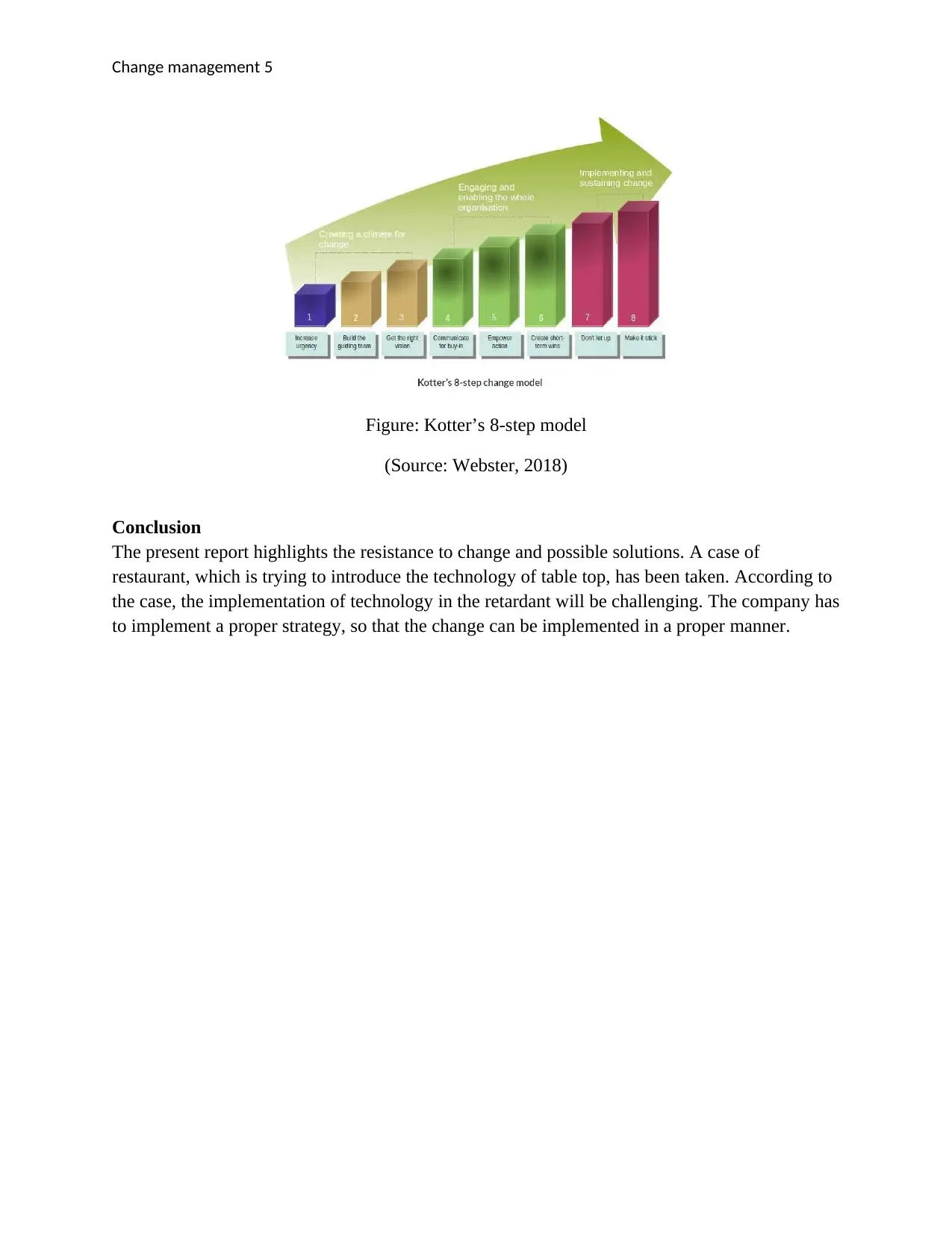
Change management 5
Figure: Kotter’s 8-step model
(Source: Webster, 2018)
Conclusion
The present report highlights the resistance to change and possible solutions. A case of
restaurant, which is trying to introduce the technology of table top, has been taken. According to
the case, the implementation of technology in the retardant will be challenging. The company has
to implement a proper strategy, so that the change can be implemented in a proper manner.
Figure: Kotter’s 8-step model
(Source: Webster, 2018)
Conclusion
The present report highlights the resistance to change and possible solutions. A case of
restaurant, which is trying to introduce the technology of table top, has been taken. According to
the case, the implementation of technology in the retardant will be challenging. The company has
to implement a proper strategy, so that the change can be implemented in a proper manner.
⊘ This is a preview!⊘
Do you want full access?
Subscribe today to unlock all pages.

Trusted by 1+ million students worldwide
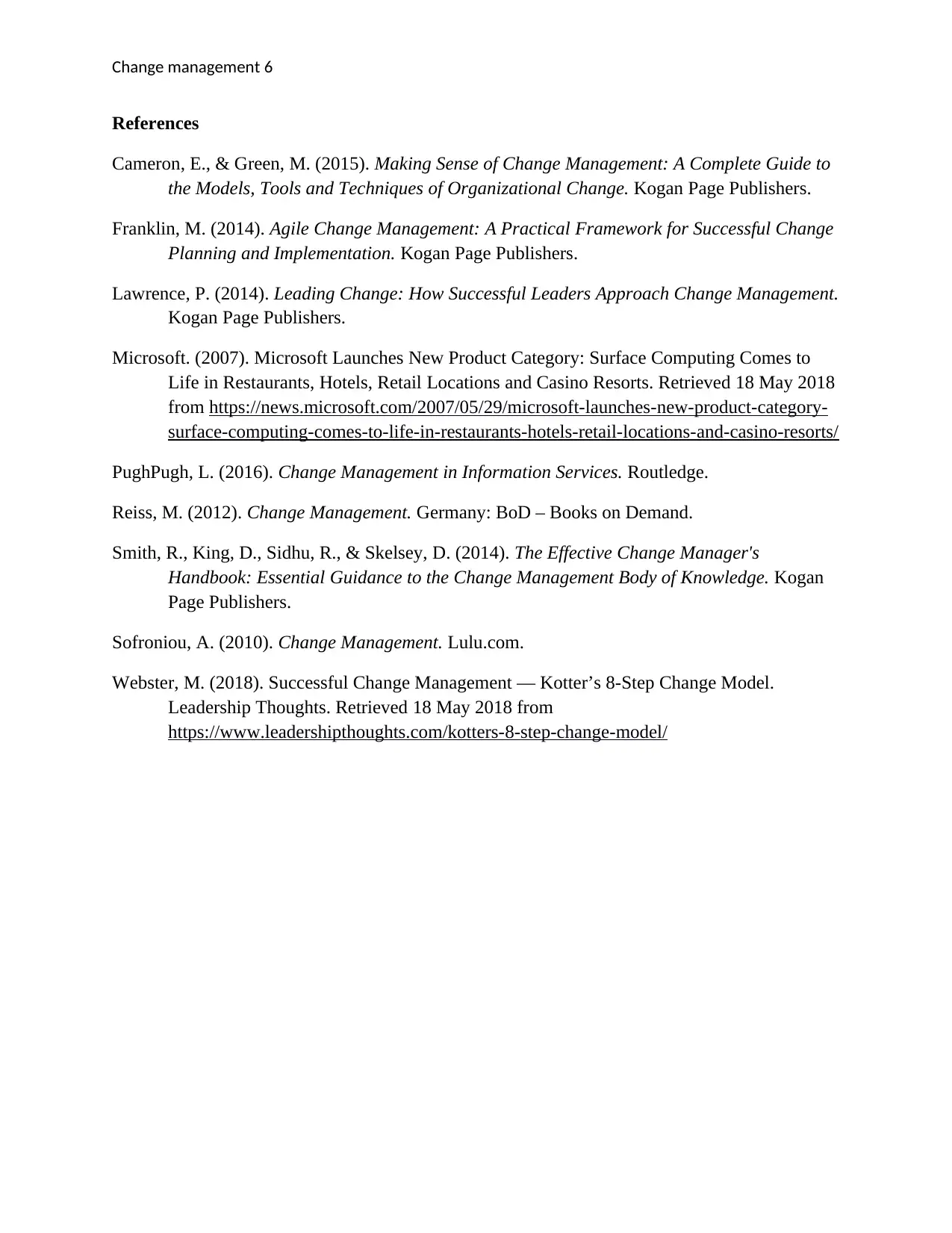
Change management 6
References
Cameron, E., & Green, M. (2015). Making Sense of Change Management: A Complete Guide to
the Models, Tools and Techniques of Organizational Change. Kogan Page Publishers.
Franklin, M. (2014). Agile Change Management: A Practical Framework for Successful Change
Planning and Implementation. Kogan Page Publishers.
Lawrence, P. (2014). Leading Change: How Successful Leaders Approach Change Management.
Kogan Page Publishers.
Microsoft. (2007). Microsoft Launches New Product Category: Surface Computing Comes to
Life in Restaurants, Hotels, Retail Locations and Casino Resorts. Retrieved 18 May 2018
from https://news.microsoft.com/2007/05/29/microsoft-launches-new-product-category-
surface-computing-comes-to-life-in-restaurants-hotels-retail-locations-and-casino-resorts/
PughPugh, L. (2016). Change Management in Information Services. Routledge.
Reiss, M. (2012). Change Management. Germany: BoD – Books on Demand.
Smith, R., King, D., Sidhu, R., & Skelsey, D. (2014). The Effective Change Manager's
Handbook: Essential Guidance to the Change Management Body of Knowledge. Kogan
Page Publishers.
Sofroniou, A. (2010). Change Management. Lulu.com.
Webster, M. (2018). Successful Change Management — Kotter’s 8-Step Change Model.
Leadership Thoughts. Retrieved 18 May 2018 from
https://www.leadershipthoughts.com/kotters-8-step-change-model/
References
Cameron, E., & Green, M. (2015). Making Sense of Change Management: A Complete Guide to
the Models, Tools and Techniques of Organizational Change. Kogan Page Publishers.
Franklin, M. (2014). Agile Change Management: A Practical Framework for Successful Change
Planning and Implementation. Kogan Page Publishers.
Lawrence, P. (2014). Leading Change: How Successful Leaders Approach Change Management.
Kogan Page Publishers.
Microsoft. (2007). Microsoft Launches New Product Category: Surface Computing Comes to
Life in Restaurants, Hotels, Retail Locations and Casino Resorts. Retrieved 18 May 2018
from https://news.microsoft.com/2007/05/29/microsoft-launches-new-product-category-
surface-computing-comes-to-life-in-restaurants-hotels-retail-locations-and-casino-resorts/
PughPugh, L. (2016). Change Management in Information Services. Routledge.
Reiss, M. (2012). Change Management. Germany: BoD – Books on Demand.
Smith, R., King, D., Sidhu, R., & Skelsey, D. (2014). The Effective Change Manager's
Handbook: Essential Guidance to the Change Management Body of Knowledge. Kogan
Page Publishers.
Sofroniou, A. (2010). Change Management. Lulu.com.
Webster, M. (2018). Successful Change Management — Kotter’s 8-Step Change Model.
Leadership Thoughts. Retrieved 18 May 2018 from
https://www.leadershipthoughts.com/kotters-8-step-change-model/
1 out of 7
Related Documents
Your All-in-One AI-Powered Toolkit for Academic Success.
+13062052269
info@desklib.com
Available 24*7 on WhatsApp / Email
![[object Object]](/_next/static/media/star-bottom.7253800d.svg)
Unlock your academic potential
Copyright © 2020–2025 A2Z Services. All Rights Reserved. Developed and managed by ZUCOL.





